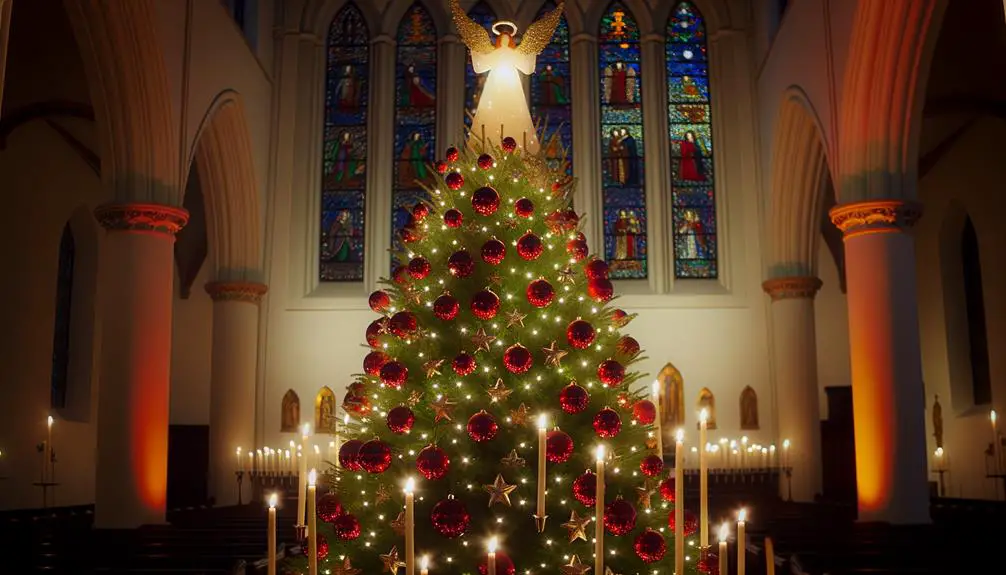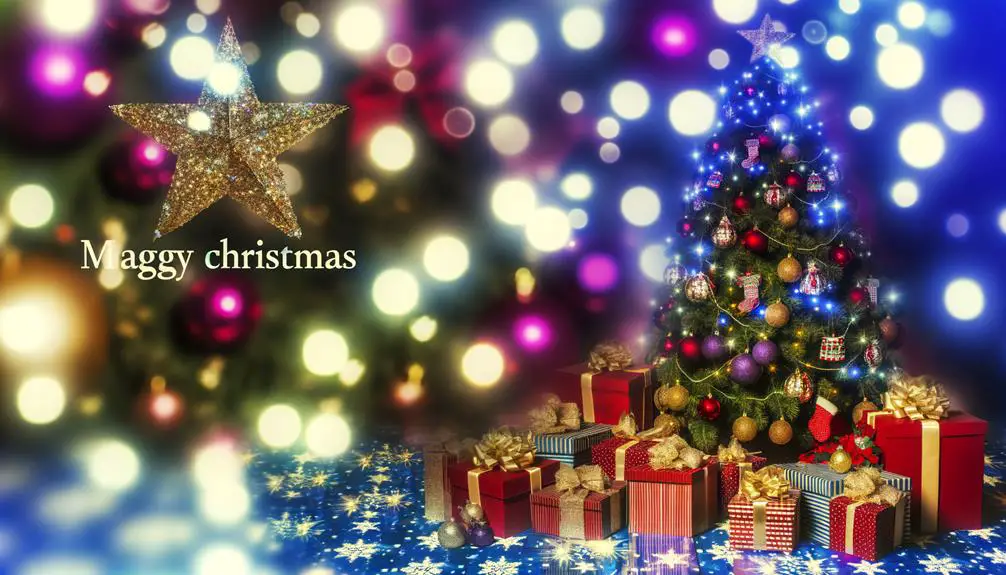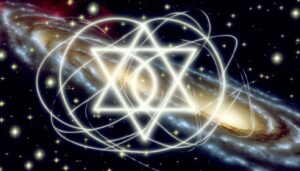Meaning of the Christmas Tree in Different Cultures
The Christmas tree, with origins in ancient pagan winter solstice celebrations, symbolizes eternal life and continuity. Early traditions from cultures like the Celts and Norse revered evergreen plants during the solstice.
In the 16th century, Germany began the modern practice of decorating trees, which soon adopted Christian symbolism. The tree's evergreen nature and triangular shape represent hope and the Holy Trinity.
Decorative elements like stars, candles, and apples hold theological significance. Today, the Christmas tree is a canvas for individual and cultural expression, embodying themes of unity and tradition.
For a deeper understanding, explore its multifaceted evolution.

Key Takeaways
- The evergreen tree symbolizes eternal life, rooted in ancient pagan and Christian traditions.
- The triangular shape of the tree represents the Holy Trinity in Christian symbolism.
- Ornaments like apples and stars carry theological meanings, such as the Garden of Eden and the Star of Bethlehem.
- Candles and lights signify Christ as the light of the world.
- Modern Christmas trees reflect personal expression, environmental awareness, and cultural inclusivity.
Historical Origins

The historical origins of the Christmas tree can be traced back to ancient pagan traditions and pre-Christian winter solstice celebrations. These early practices involved the use of evergreen boughs, symbolizing eternal life amidst the death of winter.
By the 16th century, these customs evolved into the modern Christmas tree in Germany, where devout Christians brought decorated trees into their homes. This tradition was likely influenced by medieval mystery plays, which used evergreen 'paradise trees' to represent the Garden of Eden.
The ritual of decorating these trees with candles, fruits, and nuts further imbued them with symbolic meaning. Consequently, the Christmas tree emerged as a syncretic symbol, blending ancient rituals with Christian iconography, reflecting a complex cultural and religious heritage.
Pagan Roots

Tracing the Christmas tree's symbolic roots necessitates an exploration of its pagan origins, where evergreen plants were revered and used in winter solstice festivities to honor life and renewal.
Ancient civilizations, such as the Egyptians, Celts, and Vikings, celebrated the enduring importance of evergreens during the darkest days of winter. These plants were seen as symbols of eternal life and resilience.
For example, the Celts decorated their homes with boughs of holly and ivy to ward off evil spirits during the solstice. Similarly, Norse traditions included the use of fir trees to celebrate the return of the sun.
These early customs laid the foundational symbolism that would later be adapted and transformed within various cultural contexts, signifying continuity and significance.
Christian Significance

Imbuing the Christmas tree with Christian significance involved reinterpreting its symbolism to reflect the themes of eternal life and salvation central to Christian theology.
The evergreen nature of the tree, which remains verdant throughout the year, became an emblem of the hope and continuity found in Christ's promise of eternal life.
Additionally, its triangular shape has been interpreted to represent the Holy Trinity: the Father, the Son, and the Holy Spirit.
This recontextualization of the tree's form and essence enabled early Christians to integrate a familiar, pre-existing symbol into their religious practices, thereby fostering acceptance and deeper resonance amongst converts.
Consequently, the Christmas tree evolved from a pagan symbol to a profound representation of Christian faith and divine promise.
Symbolism of Decorations

Ornaments adorning the Christmas tree carry rich symbolic meanings that reflect various cultural, historical, and theological influences. Historically, apples were hung on trees to symbolize the forbidden fruit in the Garden of Eden, representing humanity's fall and subsequent redemption through Christ.
Stars, often placed atop the tree, emulate the Star of Bethlehem, guiding the Magi to the newborn Jesus. Candles, now replaced by electric lights, represent Christ as the light of the world.
Additionally, tinsel and garlands, originally made of silver, evoke the glory and splendor of the divine. Each decoration, whether angelic figures or bells, contributes to a broader narrative that intertwines faith, tradition, and the human yearning for transcendence and hope during the Christmas season.
Modern Interpretations

In contemporary society, the Christmas tree has evolved beyond its traditional religious and cultural symbolism, embracing a diverse array of interpretations that reflect modern values and aesthetics.
The tree now serves as a canvas for individual expression, with themes ranging from environmental consciousness to artistic innovation. Eco-friendly trees made from sustainable materials highlight a growing awareness of ecological issues, while minimalist designs cater to modern tastes for simplicity and elegance.
Additionally, the Christmas tree has become a symbol of inclusivity, with people of various backgrounds incorporating unique cultural elements into their decorations. This evolution underscores the tree's adaptability, allowing it to remain relevant and meaningful in an ever-changing world, while still honoring its historical roots.
Conclusion
The Christmas tree, with its ancient roots and evolving significance, stands as a tapestry woven from diverse cultural threads. Originating from pagan traditions and later imbued with Christian symbolism, it represents both historical continuity and transformative adaptation.
The decorations, like ornaments on the branches of time, reflect societal values and individual beliefs. In modern contexts, the tree's enduring presence underscores the convergence of past and present, tradition and innovation, making it a profound symbol in contemporary celebrations.





